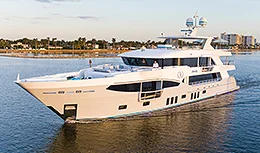- Alaskan Yachts
- Azimut Yachts
- Back Cove Yachts
- Beneteau Yachts
- Benetti Superyachts
- Bertram Yachts
- Boston Whaler
- Broward Yachts
- Buddy Davis Sportfish
- Burger Yachts
- Cabo Yachts
- Catamarans
- Carver Motoryachts
- Center Console
- Chris-Craft Yachts
- Cruisers Yachts
- DeFever Trawlers
- Dufour Sailboats
- Fairline Yachts
- Feadship Yachts
- Ferretti Yachts
- Formula Yachts
- Fountaine Pajot Cats
- Grady-White
- Grand Banks Trawlers
- Hargrave Yachts
- Hatteras Yachts
- Hinckley Picnic Boats
- Horizon Yachts
- Hydra-Sports
- Intrepid Boats
- Jarrett Bay Sportfish
- Jeanneau Yachts
- Kadey-Krogen Trawlers
- Lazzara Yachts
- Lekker Boats
- Luhrs Sportfish
- Marlow Yachts
- Maritimo Yachts
- Marquis Yachts
- Mazu Yachts
- McKinna Motoryachts
- Meridian Yachts
- Midnight Express
- MJM Yachts
- Mochi Craft
- Neptunus Motoryachts
- Nordhavn Trawlers
- Nordic Tugs
- Numarine Yachts
- Ocean Alexander Yachts
- Ocean King
- Offshore Yachts
- Outer Reef
- Oyster Sailing Yachts
- Pacific Mariner Yachts
- Palmer Johnson Yachts
Yacht Interior: Design Time
There are no rules when you work with an interior designer on your yacht. But the experts know how to ensure the interior design process is fun and fruitful instead of costly and crazy-making
This article was written by Marilyn Mower. Photography courtesy of the designers.
If you have entered into a new build contract, turning your vision into reality will be a very large task and you had best enlist very experienced help, including a designer and a project manager to work with the shipyard creating your masterpiece. A yacht will be among the largest capital commitments you ever make, and, like a home, it is a personal reflection of you. How do you choose a designer to articulate your vision? What are your expectations? Will your designer just design, supply color renderings, and shop for your furniture, fixtures and accessories, or do you expect the designer to be hands-on during the construction and assume a supervisory role? On a new build, the shipyard will likely select the interior outfitters who may or may not be part of the builder’s company. On a refit, it is more likely that you and your team will select and manage them, which puts a slightly different twist on how you choose and work with an interior designer.

There are no rules. In fact, there are as many approaches as there are yacht owners. Bad decisions, vague contracts, unclear expectations, and poor communication will lead to delays, disappointment, and cost over-runs. It takes careful planning and honest discussions to create a product that is on time, on budget, and looks like what you had imagined. We asked two designers who work both on refits and new builds how they work and for tips on what it takes to produce the intended result. Then, for a different perspective, we asked an owner’s design consultant to share the “been there, done that” perspective from the other side of the table.
Where to begin? Destry Pethel of Fort Lauderdale-based Destry Darr Design says a designer should be brought in at the earliest stages, before the yard contract is even signed. “If we talk to the owners when they are still deciding what kind of yacht experience they want, we can help guide them. They might see a boat on the brokerage market and be impressed by a look or the price, but we might realize it can’t be modified to fit their lifestyle. Not everyone has an eye for design. We have seen clients completely turned off by an interior finish or use of space and we have been able to show them it could easily be changed to match their taste and lifestyle.” On new builds, Darr likes to study the GA with the client to see if it matches their cultural requirements and lifestyle. “If they don’t want to see the crew, are there separate entrances and pathways around the boat for owners and crew? Is it for charter, and, if so, does it have the storage, crew space, and layout for successful chartering?”
“One of my clients had three directives that could never be compromised: The View, Practicality, and Privacy.”
Dee Robinson
Some builders, particularly those who build on spec as well as to order, will have an inhouse designer for their own builds as well as to assist owners who prefer not to bring in their own designer. Shelley DiCondina of Yacht Interiors by Shelley in Fort Lauderdale has that function for Hargrave Custom Yachts, but also designs refit projects for other clients. “A typical new build project for us starts after the builder has developed the general space planning with the clients. Typically, the client has spent a lot of time compiling lists of wants and needs.” DiCondina and her lead designer Rachel Orcutt-Wike refine that, developing all the details. “The challenge and the fun is to work with their lists and rough floor plans. We tweak the plans for balance, harmony, and appropriate space allocation. Then we start our series of client meetings, usually three 1- to unforeseen issues, and who hires and fires subcontractors.


“We encourage our clients to let us act as the project manager as well as designer. We have a great team of contractors we have spent years developing and we know their skills. We hire them and run the job. Managing everything about the interior work lets me keep everyone accountable and prevents bottlenecks,” Darr said.
DiCondina adds, “The biggest pitfalls with refits are insufficient time or owners who want to use the boat in the middle of the project. Then there is the yacht manager who decides to haul the boat out of the water in the middle of the project. We are very specific in the beginning that our timeline does not include yard time on the hard or the time it takes to stop and restart work.”
Darr’s top tip is to be clear about budgets in the beginning. “There are various ways to price a job depending on the scope of the work. Flat fees, cost-plus, hourly rate…transparency is the best way to go. The clients should be prepared to communicate well on budget items and they should always have a contingency because in every case, projects grow.”
“We share a basic fee schedule at the first meeting,” notes DiCondina. “For refits, we show them our previous work, talk about their project scope and see if we are a good fit. After that, we require a deposit to get started on their selections, drawings, and, eventually, proposals. All selections [and mark ups] are approved before purchase. We invoice for our time at an hourly rate.”

Dee Robinson is a long-time yacht designer in her own right, however her last four projects—two yachts and two private residences—have been as the owner’s design consultant, supervising both the design team and the fitting out, for a very busy client who lived far from each project. Here are her tips for owners:
“As you interview designers, you want to be confident that given complete and correct information, including your cultural requirements, personal preferences, lifestyle, budgetary, and quality expectations, that the designer has demonstrated their ability to communicate with the builder and their contractors and execute it 100%. One of my clients had three directives that could never be compromised: the view, practicality, and privacy. Establish your own explicit directives at the beginning,” Robinson says. She says owners should request references from other owners and the chosen builder. “Ask the brutal question: Would you retain this designer again?”
“Generally speaking, there are two types of designers. One has a ‘look’. If you like that ‘look’, go for it! The other type of designer has no ‘look’ of their own. All their projects are totally different and that’s because they reflect the ‘look’ of each owner, not themselves. Choose wisely. One may be able to layout your project in a minimal amount of time in a tasteful and widely accepted manner. The other will ask for much more of your time because they are starting with a blank slate. Going into your project, your designer may have an enthusiastic ‘vision’ of his or her own.

“Don’t be hesitant to request alternative layouts, designs, and/or materials if what is first presented misses the mark. Explain why and give the designer another opportunity to come closer to your expectations. This is not unusual in the process. If you are requesting a feature that is totally ill-advised by both the designer and the builder, ask why and what alternatives they can offer that will be satisfactory. If resale is a consideration, ask if and how it would be affected.”
When it comes to budget, she cautions to ask specifically if approved designs and materials are within your budget, or be willing to adjust it accordingly with approved change orders. For owner-furnished décor items, establish a realistic budget for loose furnishings, art, et cetera, that is agreeable to both of you.
Finally, Robinson says, designers aren’t mind readers. “You expect your selected designer to know yachts, including the designing, building, and engineering process along with the décor applications from years of experience, but you can‘t expect them to know you and your experiences. You have to build that bridge. There is no way to assure a successful project unless both parties meet in a respectful manner with willingness to communicate and to compromise when necessary.”

Request a Copy
Special Thanks to Our Sponsors








